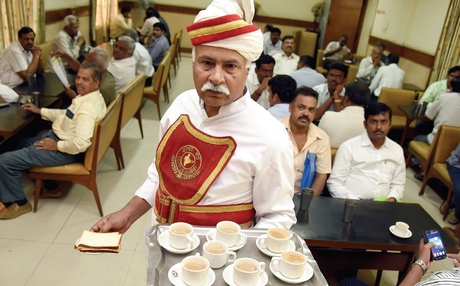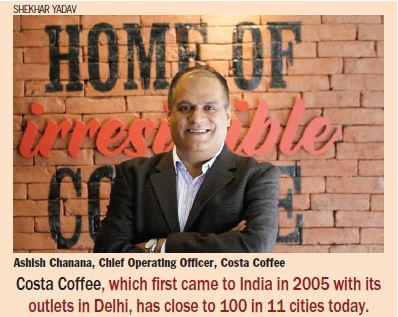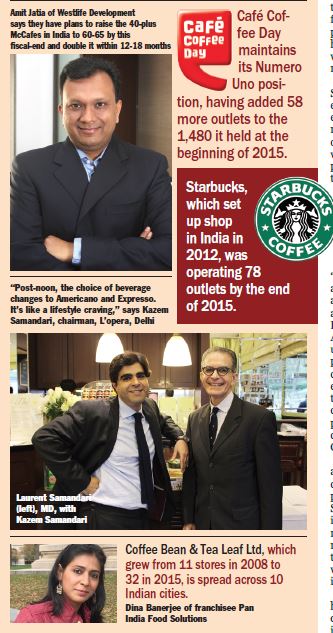
Chennai-based actress, model and ex-VJ Pooja Gallyot graduated from green tea to coffee last year and now is so hung up on the beverage that she is fast becoming an addict. On the other hand, Kolkata-based fashion designer Kiran Uttam Ghosh, a bona fide coffee lover, zeroes in on new cafes in the places she visits. For naturalist and wildlife conservationist Shrilekha, coffee shops present the ideal rendezvous to conduct business. It is these little tell-tale signs that have had coffee majors scent a business opportunity, even cleverly imparting magical qualities to the brew in that anything can happen over a cuppa. Truth be said, it’s a dramatic cultural switch that’s got the entire nation swaddled in its intoxicating embrace. According to the latest Technopak report, the chain café market, currently at Rs 1,820 crore, is growing at 20 per cent in value and commanding 27 per cent of the Rs 6,750 crore overall cafe market.
Were it not for pilgrim Baba Budan’s temerity in smuggling a few coffee beans into Chickmagalur, Karnataka, we might never have got introduced to this refreshing drink. This history aside, coffee seems to be edging out tea in the social circuit with cafes being the perfect place to hang out, chat or simply relax. That certainly augurs well for business, with Café Coffee Day, popularly called CCD, the biggest player in the Indian market, competing with international brands such as Starbucks, Barista and Costa Coffee, not to mention the popular local hangouts.
To date, CCD maintains its Numero Uno position having added 58 more outlets to the 1,480 it held at the beginning of 2015. CCD’s principal Coffee Day Enterprises set the stock market abuzz with the largest Initial Public Offering last year. It had fixed its public offer price at Rs 328 per share, taking the total proceeds to Rs 1,150 crore. But when the IPO closed on October 16, it was over-subscribed 1.81 times with a demand worth Rs 2,000 crore.
“Customers today are looking at a differentiated food experience along with their coffees at cafes. Which is why we have introduced a special food menu called the ‘SuperMenu’—a range of soups, sandwiches, burgers and desserts,” says a CCD spokesperson. “We have also started a home delivery service in Bengaluru as a pilot project.”
Costa Coffee entered India in 2005 when it opened outlets at Connaught Place in Delhi. Today, it has close to 100 in 11 cities across India. While a good number is present in metro cities such as Delhi, Mumbai, Chennai and Bengaluru, they’re spreading out in tier II cities such as Agra, Jaipur, Pune, Kochi, Ludhiana, Chandigarh and others. “While southern states have always had a strong culture of drinking coffee, over the past decade or so, the drink has penetrated to other parts too,” says Ashish Chanana, Chief Operating Officer, Costa Coffee.
Another chain that is fast expanding is the US-based Coffee Bean & Tea Leaf Ltd, which tied up with Pan India Solutions to start a single outlet at Select Citywalk mall in Delhi. It has grown to 32 stores in 10 cities from 11 in 2008. “We source our coffee from seven different countries,” says Dina Banerjee, CMO, Pan India Food Solutions Pvt Ltd, Mumbai.
Though all eyes are on the newest entrant, US giant Starbucks, which joined hands with Tata Coffee Ltd to set up shop in India in 2012. By 2014, it had more than 60 outlets and the end of 2015 saw it operating 78. It had also managed to clock in Rs 171.2 crore, an 80 per cent jump from previous year’s Rs 95 crore.
Coffee shops have so much become revenue models that another giant has jumped on the bandwagon.
The most telling of entries is American fastfood chain McDonald’s McCafe in the country with its first cafe being launched in Mumbai. “The concept fits in well with what the Indian customer needs. Our plan is to increase the 40-plus McCafes to 60-65 by this fiscal-end and double it within 12-18 months,” says Amit Jatia, Vice Chairman, Westlife Development, franchisee of McDonald’s in South and West India.
There’s a good reason behind the dramatic rise of coffee cafes in India. Fashion designer Ghosh spends her holidays finding new cafes and spending her time reading, sketching and dreaming there. “Cafes across the world reflect the essence of its people and place,” she says, adding that the habit of going to cafes late at night with friends has earned them the moniker, ‘the owls’.
Chanana is in agreement too. Says he: “Coffee shops have given people across all age groups—especially the young—a legitimate, safe and cool place to hang out. Youngsters can go on a date without burning a hole in their pocket. Friends can spend time together at a conveniently located place. We’re also seeing a lot of older couples taking time out to catch up with each other over a cup of coffee. At Costa, we have lots of customers who are by themselves.”
Gallyot is a big fan of Starbucks. “I have gotten used to their coffee as wherever I travelled, I came across an outlet. It’s become like a comfort drink for me,” she says. For 24-year-old MBBS student Anjali Reddy, Starbucks doubles up as a place for study. In fact, people have come to associate coffee concoctions with different times of the day. “Post-noon, the choice of beverage quickly changes to Americano and Expresso. It’s become like a lifestyle craving,” says Kazem Samandari, Chairman of L’opera, Delhi.
Besides cultivating friendships and fun, these places have become the haunt of many working people. Wildlife conservationist Shrilekha often frequents Chamiers, an upmarket café in Chennai. “As I work from home, I often meet business associates at cafeterias and I love Chamiers which while elegant has a lot of breathing space,” shares Shrilekha.
Visiting cafes has widened the horizon of Delhi-based interior designer Parull Mahajan’s social interactions. The caffeine rush helps her mind to stimulate her creativity. “I visit the two of my favourite cafes—Choko La and Starbucks—at least three-four times a week and cannot do without my standard two or three cups a day. It’s an addiction I have no intention of wearing off,” she says.
In keeping with the global trend, coffee shops have become de facto offices for consultants, entrepreneurs, and writers. “Some of our Costa outlets in Delhi, Bengaluru and Mumbai have had the privilege of hosting many start-ups, where the founders polished their business idea over several cups of coffee,” says Chanana. Work is also what takes Anitha KS, National Corporate Sales Manager at Vodafone, to Costa Coffee at the Lulu Mall in Kochi. “After meeting clients in the morning, I come here and carry on my work sipping on a cold coffee or cappuccino,” says Anitha. For his part, the outlet’s manager Anup Anand is delighted with the increased bottom line. “We have plans to open more outlets in Kochi and other cities of Kerala.” That’s significant given that Kerala is predominantly a tea-drinking state.
Coffee reigns with an aromatic fist even as south India leads in the production of coffee, with the drink dominating social interactions. Apart from the big players, there are a host of small and medium joints that gets people over for coffee and chitchat. In Bengaluru, which is the hub for rich traditional filter coffee, local brands such as Maiyas, Adigas, Shanthi Sagars, the SLVs, Hatti Kapi, Katte Kapi, Brahmin’s Coffee Bar and Coffee Board outlets are still going strong. Small joints rule the roost in Chennai too, courtesy Madras Coffee House, Leo coffee outlets (under brand Mylapore Mocha) and Kumbakonam degree coffee outlets.
Unique to the Bengaluru-Mysuru region is the ‘by-two’ coffee culture, a mini dose of coffee whose origins can be traced to some 100 years back during the literary and Independence movements. Then literary figures, freedom fighters and political leaders, with hardly any money in their pockets, gave impetus to this culture of having multiple servings of half a cup of coffee over endless discussions.
For many in the garden city, the small joints are the place to be. Marketing professional R N Prasad feels that the prominent coffee cafes are good only to conduct business with coffee being incidental. Each day, he drives some seven kilometres to have a cup of coffee at the Brahmin’s Coffee Bar. According to city historian Arun Prasad, tourists prefer the traditional filter coffee served at small joints.
In the grand theatre of coffee culture, there are the veterans—India Coffee House and Coffee Board outlets. K S Achyuthan, Kannada author and media professional, has been visiting the Coffee Board outlet near Vidhana Soudha in Bengaluru for more than 50 years. “This is a meeting point for many journalists and lawyers as well as musicians and guests who come to All India Radio. I have also seen many legislators, MPs and even celebrities in this place which has hardly changed all these years.” Kannada filmmaker and environmentalist Suresh Heblikar makes it a point to visit India Coffee House whenever he passes by the place.
The India Coffee House in Puducherry, a heritage structure, came close to being torn down in 2008 until INTACH and concerned citizens appealed against the move. With CM N Rangaswamy’s support and renovations later, it opened in mid-2014 and has begun to attract crowds. This outlet also finds a mention in Yann Martel’s Life of Pi.
Looks like the old and the new will exist side by side even as coffee aficionados seek out their happy place.
with Meera Bhardwaj, Ayesha Singh, Shevlin Sebastian, Jonathan Ananda and Suhas Yellapuntala
source: http://www.newindianexpress.com / The New Indian Express / Home> Magazine / by Sunita Raghu / January 23rd, 2016




